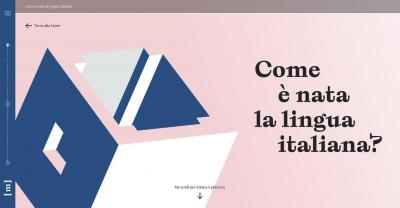New virtual museum opens dedicated to the Italian Language

ROME – “The Multi” - The first virtual museum dedicated to the story of the Italian languages and its history will launch on June 1. An enthralling multimedia journey with high resolution visual exhibits, animations, and interactive games was born from the collaboration between the Universities of Pavia, Naples L'Orientale and Tuscia, and realised by the multidisciplinary design studio Dotdotdot.
The Multi was realised thanks to a project financed by the Ministry of University and Research under the FISR 2019 (Special Supplementary Fund for Research), was previewed today at the University of Pavia as part of the conference "The Museum of the Italian Language. Le molte facce di un'idea" and will be freely accessible online to all from June 1.
The presentation of the Multi is accompanied by the publication of "Verso il Museo multimediale della lingua italiana. Riflessioni, esperienze, linguaggi" (il Mulino), a volume edited by Giuseppe Antonelli (national coordinator of the research) with Giacomo Micheletti and Stella Poli, in which reflections related to the idea of digital museum are collected.
The Multi is designed to preserve, hand down and valorise the intangible cultural heritage constituted by the Italian language and its many facets, making it emerge as a "living thing," an instrument of expression and growth of society. Thanks to an intuitive interface and an easily navigable structure, the Multi addresses a vast and heterogeneous public. Its digital paths combine narrative languages, images, video and audio to create an immersive and surprising experience.
The English-language version, which will be completed in the coming weeks, is also aimed at an international audience. The structure of the Multimedia Museum of the Italian Language unfolds through an introductory atrium and six interactive and intuitive thematic paths, which answer many fundamental questions about our language: How did the Italian language come into being? Who established the rules of Italian? How did written Italian circulate? How did spoken Italian spread?
From the autographs of Dante and Petrarch, to the memorial written in her own hand in the 16th century of a woman accused of witchcraft, the narrative is organised according to the logic of scrollytelling. It is in fact through the mechanism of scrolling that the digital objects that bring the story to life are encountered, through text, images, animation, video, audio and interactive games, in line with the principle of mixed media content.
"Multi's challenge is to tell the story of the Italian language and its history in a way that can involve and enthuse a wide and varied audience: from the young people in our schools to all the people around the world who love our language and are intrigued by it,” said Giuseppe Antonelli, lecturer in History of the Italian Language at the University of Pavia and scientific coordinator of Multi.
The realisation of Multi, from the design of the visual identity and user experience to the development of the platform, was entrusted to the Dotdotdot studio - founded in Milan in 2004 and one of the first in Italy to work in the field of interaction design - which undertook to translate into a multimedia mode the visiting experience that takes place in a physical museum and to systematise and order the ideas with respect to the design objectives, maintaining the main element of observation the role that the museum plays in narrating, preserving and protecting cultural heritage.
"As with all our projects, in designing the Multi we gave centrality to the user experience, translating what happens in a physical museum into a multimedia mode. The visitor's curiosity is guided by a few questions that accompany him along curatorial paths to discover the history of the Italian language,” said Alessandro Masserdotti, co-founder and CTO of Dotdotdot.
eb
© COPYRIGHT ITALIAN INSIDER
UNAUTHORISED REPRODUCTION FORBIDDEN


